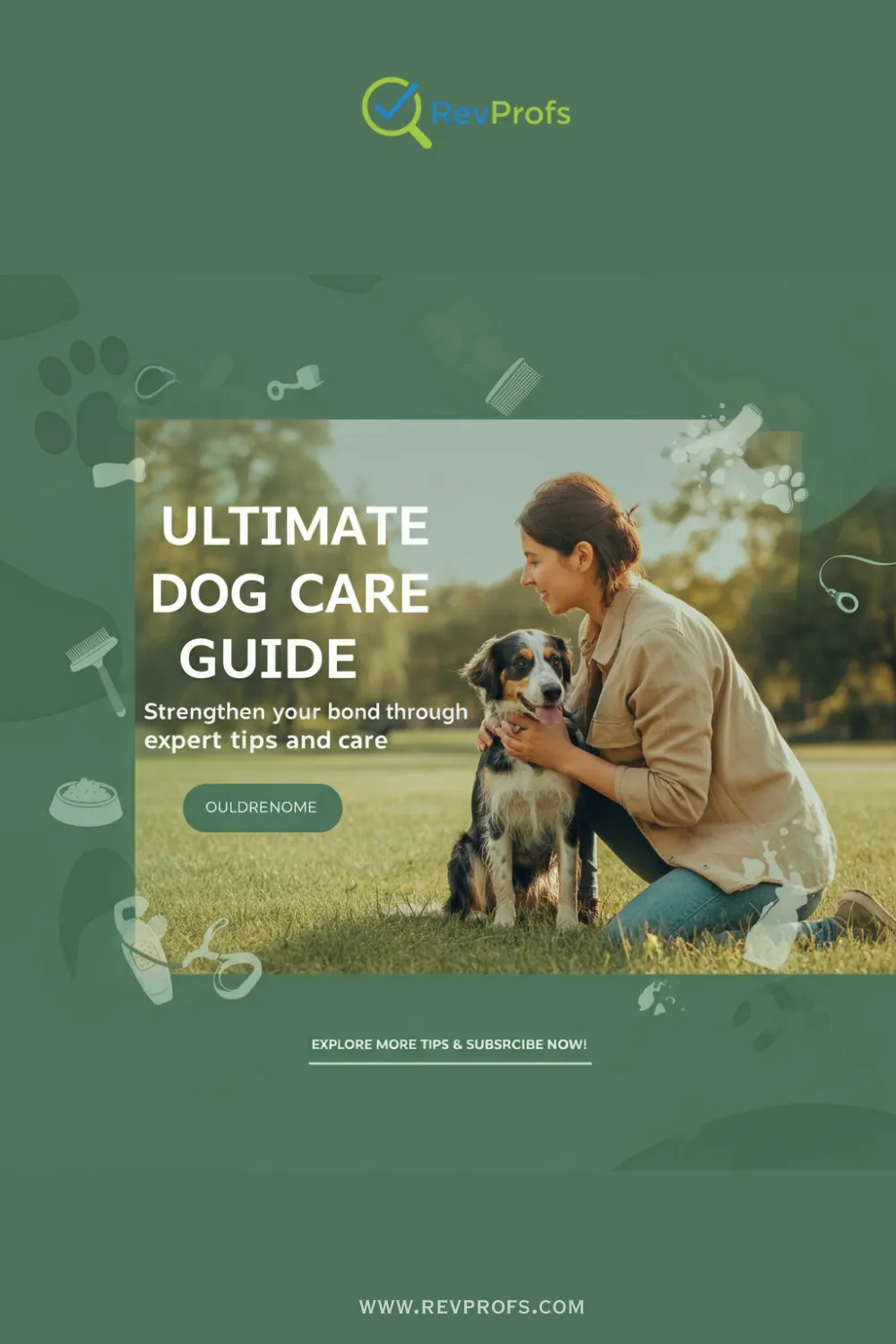The Ultimate Guide to Dog Care
Bringing a dog into your life is one of the most rewarding experiences you can have. They offer unconditional love, endless entertainment, and a unique companionship that enriches our lives in countless ways. But being a great dog owner is more than just belly rubs and games of fetch. It’s a significant commitment that requires knowledge, patience, and a deep sense of responsibility. Providing excellent dog care is the foundation for a long, happy, and healthy relationship with your furry friend.
Understanding and meeting your dog’s needs is crucial for their well-being. Proper care impacts everything from their physical health to their emotional stability. A well-cared-for dog is not only healthier but also happier and better behaved. This comprehensive dog care guide is designed to be your go-to resource, whether you’re welcoming your very first puppy or you’re an experienced owner looking to refine your practices. We’ll cover everything you need to know to ensure your companion thrives.
From deciphering the complexities of dog nutrition to mastering the basics of training and socialization, this guide will provide clear, actionable advice. We will explore essential topics like grooming, exercise, veterinary care, and even how to travel safely with your dog. Think of this as your roadmap to becoming the best pet parent you can be. By investing time in learning these fundamentals, you are making a profound investment in your dog’s quality of life and strengthening the incredible bond you share. Let’s get started on this wonderful journey together.
Understanding Your Dog’s Needs
Every dog is a unique individual, but all dogs share a fundamental set of needs that must be met for them to live a full and happy life. Understanding these needs—both physical and emotional—is the first step in responsible pet ownership. It’s about creating an environment where your dog doesn’t just survive, but truly flourishes.
Physical vs. Emotional Needs
A holistic approach to dog care recognizes that a dog’s well-being depends on more than just physical health.
Physical Needs: These are the tangible requirements for keeping your dog’s body healthy.
- Proper Nutrition: A balanced diet appropriate for their age, breed, and activity level.
- Fresh Water: Constant access to clean, fresh water.
- Adequate Shelter: A safe, comfortable, and clean living space that protects them from the elements.
- Regular Exercise: Daily physical activity to maintain a healthy weight and burn off energy.
- Consistent Grooming: Regular brushing, bathing, and nail trims to keep their coat and skin healthy.
- Veterinary Care: Routine check-ups, vaccinations, and prompt attention to illness or injury.
Emotional Needs: These are just as vital as physical needs and contribute to your dog’s mental and behavioral health.
- Affection and Companionship: Dogs are social animals who crave connection with their human family.
- Mental Stimulation: Puzzles, training, and new experiences to keep their minds sharp and prevent boredom.
- Sense of Security: A predictable routine and a safe environment help a dog feel secure.
- Positive Socialization: Gentle and positive introductions to other people and animals build confidence.
- Training and Guidance: Clear rules and positive reinforcement training provide structure and help them understand how to behave.
Failing to meet these emotional needs can lead to dog behavior problems like anxiety, destructiveness, and aggression. A happy dog is one whose mind is as well-cared-for as their body.
Breed-Specific Care Considerations
While all dogs share basic needs, their breed plays a significant role in their specific care requirements. From energy levels to grooming needs and potential health issues, understanding your dog’s breed background is essential.
- Energy and Exercise: A Border Collie, bred for herding sheep all day, will require far more exercise than a Basset Hound. Research your breed’s typical energy level to create a suitable dog exercise routine.
- Grooming: A Poodle with a continuously growing, curly coat needs professional grooming every 4-6 weeks, whereas a short-haired Beagle might only need occasional brushing. Long-haired breeds are also more prone to matting, which can be painful.
- Health Predispositions: Certain breeds are prone to specific health conditions. For example, German Shepherds are susceptible to hip dysplasia, while Bulldogs often face respiratory issues. Being aware of these risks allows for proactive dog health care and early detection.
- Temperament: A breed’s original purpose often influences its temperament. A Siberian Husky might have a strong prey drive and a tendency to roam, while a Labrador Retriever is often social and eager to please. This knowledge is crucial for effective dog training basics.
Creating a Safe Home Environment
“Dog-proofing” your home is a critical step, especially when bringing home a new dog or puppy. It involves looking at your home from your dog’s perspective to identify and remove potential hazards.
- Secure Toxic Substances: Household cleaners, antifreeze, pesticides, and certain plants (like lilies, tulips, and oleander) are highly toxic to dogs. Store them in locked cabinets or on high shelves.
- Hide Electrical Cords: Puppies and even some adult dogs may chew on electrical cords, risking burns or electrocution. Tuck them away, use cord concealers, or apply a bitter-tasting spray.
- Secure Trash Cans: Kitchen garbage can contain dangerous items like cooked bones, toxic foods (onions, grapes), and choking hazards. Use a can with a secure lid.
- Create a Safe Space: Provide a designated safe space for your dog, such as a crate or a comfy bed in a quiet corner. This gives them a personal retreat where they can rest undisturbed.
- Yard Safety: Ensure your yard is securely fenced to prevent escapes. Check for and remove any toxic plants and ensure there’s access to shade and fresh water.

Dog Nutrition
Proper nutrition is one of the most critical components of your dog care guide. The food you choose directly impacts your dog’s energy levels, coat health, immune system, and overall longevity. With so many options on the market, choosing the best dog food can feel overwhelming, but understanding the basics will empower you to make an informed decision.
Types of Dog Food
There are four main categories of dog food, each with its own set of pros and cons.
- Dry Food (Kibble): This is the most popular and often most affordable option. High-quality kibble is formulated to be nutritionally complete and balanced. Its crunchy texture can also help with dental hygiene by reducing tartar buildup. Look for brands that list a specific meat source (like chicken or lamb, not “meat meal”) as the first ingredient.
- Wet Food (Canned): Wet food has high moisture content, which can be beneficial for dogs who don’t drink enough water and for urinary tract health. It’s also highly palatable, making it a good choice for picky eaters or senior dogs with dental issues. However, it’s generally more expensive and requires refrigeration after opening.
- Raw Food (BARF/RMBD): The Biologically Appropriate Raw Food (BARF) diet consists of raw meat, bones, fruits, and vegetables. Proponents argue it’s a more natural diet that leads to shinier coats, healthier skin, and smaller stools. However, it carries risks of bacterial contamination (for both dogs and humans) and potential for an unbalanced diet if not prepared correctly. Consult with a veterinary nutritionist before starting a raw diet.
- Homemade Food: Preparing your dog’s meals at home gives you complete control over the ingredients. This can be an excellent option for dogs with specific allergies or health conditions. Like raw feeding, it is crucial to work with a veterinarian or a board-certified veterinary nutritionist to ensure the diet is complete and balanced. An imbalanced homemade diet can lead to serious nutritional deficiencies.
Feeding Schedules by Life Stage
A dog’s nutritional needs change as they age.
- Puppy Care Guide (Up to 1 year): Puppies are growing rapidly and need more calories, protein, and specific nutrients like calcium. Feed a high-quality puppy formula 3-4 times a day. Small breeds may transition to adult food around 9-12 months, while large breeds should stay on puppy food (specifically large-breed puppy formula) longer to support proper bone development.
- Adult Dogs (1-7 years): Most adult dogs do well with two meals a day. The amount of food depends on their size, breed, and activity level. Follow the guidelines on the food packaging as a starting point, but adjust as needed to maintain a healthy body condition. You should be able to feel their ribs easily but not see them.
- Senior Dogs (7+ years): Senior dogs are typically less active and have a slower metabolism, so they may require fewer calories to prevent obesity. Some senior formulas include ingredients like glucosamine to support joint health. They may also benefit from more frequent, smaller meals if they have digestive issues.
Foods to Avoid
Many human foods are toxic to dogs. Never feed your dog the following:
- Chocolate: Contains theobromine, which is toxic to dogs.
- Onions, Garlic, and Chives: Can cause damage to red blood cells.
- Grapes and Raisins: Can cause acute kidney failure.
- Xylitol: An artificial sweetener found in gum, candy, and some peanut butters that is extremely toxic.
- Alcohol: Can cause intoxication, coma, and death.
- Cooked Bones: Can splinter and cause choking or internal damage.
- Macadamia Nuts: Can cause weakness, vomiting, and tremors.
Grooming & Hygiene
Grooming is about more than just keeping your dog looking good; it’s an essential part of their health and well-being. Regular grooming helps prevent skin problems, parasites, and painful matting. It’s also a great opportunity to bond with your dog and check for any unusual lumps, bumps, or sores. These dog grooming tips will help you establish a solid routine.
Brushing Techniques
Brushing removes loose hair, dirt, and dander, and it distributes natural oils throughout the coat, keeping it healthy and shiny.
- Frequency: Short-haired breeds may only need brushing once a week, while long-haired breeds (like Golden Retrievers or Collies) need daily brushing to prevent tangles and mats.
- Tools: The right brush depends on your dog’s coat. A bristle brush works for most coat types, a pin brush is good for long, silky coats, and an undercoat rake is essential for double-coated breeds (like Huskies and German Shepherds) to remove loose undercoat during shedding seasons.
- Technique: Always brush in the direction of hair growth. Be gentle, especially around sensitive areas. If you encounter a tangle, try to work it out gently with your fingers or a de-matting comb rather than pulling on it.
Bathing Frequency
Over-bathing can strip a dog’s coat of its natural oils, leading to dry, irritated skin. Most dogs only need a bath every 1-3 months, or when they get particularly dirty. Always use a shampoo specifically formulated for dogs, as human shampoos have a different pH and can be harsh on their skin.
Nail Trimming Guide
Long nails can be uncomfortable for your dog, affecting their posture and potentially growing into their paw pads.
- How Often: Trim your dog’s nails every 3-4 weeks. If you can hear their nails clicking on the floor, they’re too long.
- Tools: You can use either guillotine-style clippers or grinder tools.
- The Quick: The quick is a blood vessel that runs into the nail. In dogs with light-colored nails, you can see it as a pink area. Avoid cutting the quick, as it’s painful and will bleed. If you’re unsure, it’s better to trim a small amount more frequently. Having styptic powder on hand can quickly stop any accidental bleeding.
Dental Care Routine
Dental disease is incredibly common in dogs and can lead to pain, tooth loss, and even systemic health problems.
- Brushing: Ideally, you should brush your dog’s teeth daily using a dog-specific toothbrush and toothpaste. Never use human toothpaste.
- Dental Chews: Certain dental chews and toys can help reduce plaque and tartar buildup. Look for products with the Veterinary Oral Health Council (VOHC) seal of approval.
- Professional Cleanings: Most dogs will require professional dental cleanings under anesthesia at some point. Your vet can advise you on the appropriate schedule based on your dog’s dental health.
Training & Socialization
Training and socialization are gifts you give your dog that last a lifetime. A well-trained and socialized dog is confident, well-behaved, and a joy to be around. This process builds a strong line of communication and deepens the bond between you and your pet. It’s a key part of preventing dog behavior problems down the road.
Basic Obedience Commands
Teaching basic obedience is the foundation of dog training basics. Use positive reinforcement methods—rewarding desired behaviors with treats, praise, or toys—to make learning fun. Keep training sessions short and positive (5-10 minutes).
- Sit: Hold a treat over your dog’s head and move it slightly backward. As their head goes up, their rear will go down. The moment they sit, say “Sit” and give them the treat.
- Stay: Ask your dog to sit. Hold your hand up in a “stop” signal and say “Stay.” Take one step back. If they stay, step back to them and give them a treat. Gradually increase the distance and duration.
- Come: In an excited tone, say “Come!” and back away from your dog. When they come to you, give them lots of praise and a high-value treat. Never punish your dog for coming to you, even if you’re upset about something they did.
- Leave It: Hold a low-value treat in a closed fist. Let your dog sniff and lick your hand. The moment they pull their head away, say “Leave it” and give them a high-value treat from your other hand.
Crate & House Training
- Crate Training: Introduce the crate as a safe, comfortable den—never as a punishment. Make it cozy with a soft blanket. Feed meals in the crate and provide special toys that they only get inside the crate. Start by closing the door for very short periods and gradually increase the time.
- House Training: A consistent routine is key. Take your puppy out first thing in the morning, last thing at night, and after every meal, nap, and play session. Take them to the same spot each time. When they eliminate outside, praise them enthusiastically. Expect accidents, and clean them up with an enzymatic cleaner to eliminate odors that might attract them back to the same spot.
Socialization Tips
Socialization is the process of exposing your puppy to various sights, sounds, people, and other animals in a positive way between the ages of 3 and 16 weeks. Proper socialization helps prevent fear and aggression later in life.
- Introduce them to different types of people (men, women, children, people in hats).
- Expose them to different sounds (vacuum cleaner, traffic).
- Let them walk on different surfaces (grass, pavement, carpet).
- Arrange supervised playdates with well-behaved, vaccinated adult dogs.
Exercise & Mental Stimulation
A tired dog is a good dog. Exercise and mental stimulation are crucial for preventing boredom-related behaviors like chewing, barking, and digging. The right amount and type of activity will help keep your dog physically fit and mentally sharp.
Daily Exercise Needs by Breed
A dog’s exercise needs are heavily influenced by their breed, age, and individual energy level. A well-structured dog exercise routine is vital.
- High-Energy Breeds: Breeds like Border Collies, Australian Shepherds, and Jack Russell Terriers need at least 60-90 minutes of vigorous exercise per day. This can include running, hiking, or intense games of fetch.
- Moderate-Energy Breeds: Breeds like Labrador Retrievers, Golden Retrievers, and Poodles thrive on about 45-60 minutes of daily activity, such as brisk walks, swimming, or playing at the dog park.
- Low-Energy Breeds: Breeds like Bulldogs, Basset Hounds, and Pugs are content with 20-30 minutes of walking per day. Be mindful of brachycephalic (flat-faced) breeds, as they can overheat easily.
Indoor & Outdoor Activities
- Outdoor: Brisk walks, running, hiking, swimming, and fetch are all excellent forms of physical exercise.
- Indoor: On days when you can’t get outside, play games like tug-of-war, hide-and-seek, or set up an indoor agility course with pillows and furniture.
Mental Enrichment Games
Mental exercise is just as important as physical exercise.
- Puzzle Toys: Food-dispensing puzzle toys require your dog to work to get their kibble, turning mealtime into a fun challenge.
- Nose Work: Hide treats around the house and encourage your dog to “find it.” This engages their powerful sense of smell.
- Learning New Tricks: Teaching new commands or tricks is a fantastic way to engage your dog’s brain and strengthen your bond.
Dog Health & Veterinary Care
Proactive dog health care is essential for a long and healthy life. This involves a partnership with your veterinarian for routine care, vaccinations, and prompt treatment of any health issues.
Vaccination Schedule
Vaccinations protect your dog from a range of serious and potentially fatal diseases. Your vet will recommend a schedule based on your dog’s age and risk factors, but a typical puppy care guide for vaccines includes:
- Core Vaccines: These are recommended for all dogs and include protection against Distemper, Hepatitis, Parainfluenza, and Parvovirus (DHPP), as well as Rabies.
- Non-Core Vaccines: These may be recommended based on your dog’s lifestyle and geographic location, and include vaccines for Bordetella (kennel cough), Leptospirosis, and Lyme disease.
Common Illnesses & Early Signs
Be vigilant for signs of illness. Early detection can make a significant difference in treatment outcomes. Watch for:
- Changes in appetite or water consumption
- Lethargy or changes in energy levels
- Vomiting or diarrhea
- Coughing or sneezing
- Limping or difficulty moving
- Changes in urination or defecation
Parasite Prevention
Parasites like fleas, ticks, and heartworms are more than just a nuisance; they can transmit serious diseases.
- Fleas & Ticks: Use a monthly preventative (topical, oral, or collar) as recommended by your vet.
- Heartworm: This deadly disease is transmitted by mosquitoes. A monthly preventative medication is crucial for protection.
Traveling With Your Dog
Traveling with your dog can be a fun adventure, but it requires careful planning to ensure their safety and comfort.
Car Travel Safety
- Secure Your Dog: Never let your dog roam free in a moving vehicle. Use a well-ventilated travel crate, a dog seatbelt, or a car barrier to keep them secure. This protects them from injury and prevents them from distracting the driver.
- Never Leave Them in a Parked Car: Even on a mild day, the temperature inside a car can quickly rise to dangerous levels, leading to heatstroke and death.
- Pack Accordingly: Bring a travel bag with food, water, a bowl, leash, waste bags, medications, and a copy of their vaccination records.
Pet-Friendly Travel Tips
- Accommodations: Research and book pet-friendly hotels or accommodations in advance. Be aware of any pet fees or restrictions.
- Identification: Ensure your dog is wearing a collar with up-to-date ID tags. A microchip is also highly recommended as a permanent form of identification.
- Health Certificate: If you’re traveling across state lines or by air, you may need a health certificate from your veterinarian.
Your Path to Expert Dog Care
Becoming an expert in dog care is a continuous journey of learning and love. By focusing on the core pillars—understanding your dog’s unique needs, providing excellent nutrition, maintaining a consistent grooming and training schedule, and prioritizing their health—you are building a foundation for a wonderful life together. Remember that patience and consistency are your best tools. Every effort you make strengthens the incredible bond you share with your canine companion.
We hope this ultimate dog care guide serves as a valuable resource on your journey. To continue learning, we invite you to explore our other in-depth guides on specific topics like advanced training techniques and breed-specific nutrition.
For the latest dog care advice and exclusive offers delivered right to your inbox, subscribe to our newsletter. And if you’ve found this guide helpful, please share it with fellow dog lovers!
Ready for the Next Step?
Your pet's journey doesn't end here. Explore our expert guides to ensure they get the best care at every stage.
Puppy & Dog Care
From choosing the right food to understanding their behavior, our dog care guides cover everything you need to know.
Explore Dog GuidesGear & Product Reviews
Find honest, in-depth reviews on the latest pet gear, from smart collars to durable toys, and make informed decisions.
See All Reviews



